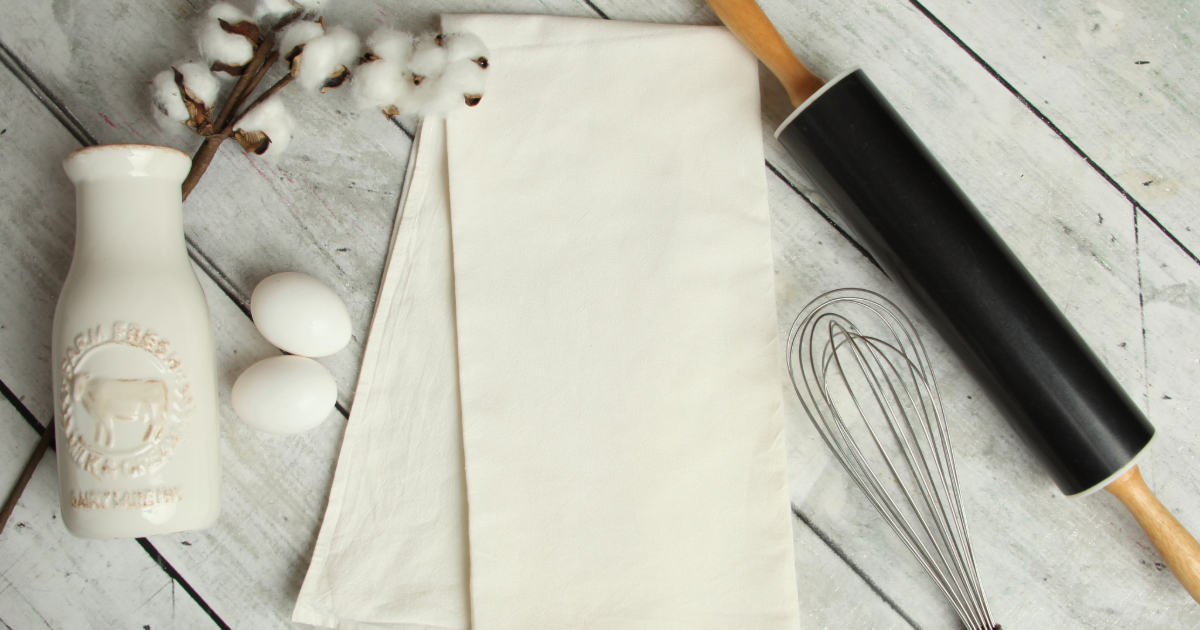Tea towels and flour sack towels are two types of versatile cotton towels that have been kitchen staples for ages. But what exactly sets them apart?

Though they share some key traits, there are several differences when it comes to their materials, intended uses, absorbency, and more.
A Brief History of Flour Sack Towels and Tea Towels
Flour sack towels and tea towels emerged at different points in history, but both became common household items.
Flour Sack Towels
As the name suggests, flour sack towels originated from the cotton sacks used to package flour and grains. During tough economic times like the Great Depression, thrifty women would upcycle these sacks into towels and other household goods.
The fabric proved perfectly suited for drying dishes, wiping up spills, straining foods, and other practical uses. Over time, flour sack towels became a multipurpose kitchen staple. Modern flour sack towels carry on the durable, absorbent legacy in a more refined form.
Tea Towels
Tea towels emerged in 18th century England and were originally used by wealthy households during afternoon tea services. The soft linen material enabled ladies to polish fine china and stemware without causing scratches or lint. Tea towels also kept teapots warm and showcased decorative embroidery.
Later on, tea towels transitioned from ornate display pieces to utilitarian kitchen helpers. They remain a popular option for drying delicate dishware and glassware.
Now that you know a bit about the origins of each, let’s explore how flour sack towels and tea towels compare.
Key Differences Between Flour Sack Towels and Tea Towels
While both towel varieties have become kitchen workhorses, there are a few differences that set them apart:
Materials
The materials used impact the towels’ textures, durability, and functionality:
- Flour sack towels are made from cotton – usually long-staple cotton interwoven in a fine, tight weave. They feel thicker and more textured than tea towels.
- Tea towels tend to be made from linen or a linen-cotton blend. This gives them a smooth, lightweight feel.
Cotton offers exceptional strength and absorbency. But linen has its perks too, namely a smooth surface that won’t leave lint or fibers behind.
Absorbency
When it comes to sopping up spills and drying dishes, flour sack towels have the upper hand:
- The looser weave makes flour sack towels ultra-absorbent. They hold more liquid than delicate tea towels.
- Tea towels still absorb reasonably well. But their finer weave causes them to retain moisture rather than rapidly absorbing it.
So for tasks where absorption is key, sturdy flour sack towels can’t be beat.
Lint and Streaks
As mentioned earlier, tea towels really shine when it comes to leaving dishes sparkling and streak-free:
- Flour sack towels won’t produce lint balls like terry cloth. But they can leave tiny cotton fibers behind.
- Tea towels made from linen or a linen-blend release virtually no lint or stray fibers. So they won’t leave traces behind on dishware.
While flour sack towels still perform well, tea towels create that polished look.
Key Takeaway: Tea towels are the best choice for drying delicate glassware or dishware since they won’t leave behind lint or fibers. Flour sack towels, while very absorbent, may leave faint cotton traces.
Versatility
In terms of versatility and multitasking in the kitchen, flour sack towels come out ahead:
- Flour sack towels serve a wider variety of purposes. From drying dishes to straining foods, they can tackle almost any kitchen task.
- Tea towels play more of a niche role – mainly for gently drying glassware and dishes. Beyond that, they aren’t quite as versatile.
So flour sack towels offer more bang for your buck if you want an all-purpose kitchen towel.
Durability
The two towels types also perform differently over time:
- Flour sack towels soften with each wash while maintaining their absorbency and durability. The more you launder them, the better they become.
- Tea towels tend to show wear sooner. Constant laundering can cause them to fray, lose their absorbency, and become less effective.
Clearly, flour sack towels deliver lasting performance compared to more delicate tea towels.
Based on these differences, you may find that each towel works better in certain scenarios:
Flour Sack Towels
- Drying dishes, glassware, and cutlery
- Mopping up large spills
- Covering rising dough
- Straining stocks and broths
- Replacing paper towels for general cleaning
Tea Towels
- Polishing and drying fine glassware
- Serving wares, like cake stands
- Protecting decorated table surfaces from heat damage
- Adding a decorative accent to kitchen décor
Keep reading for more details on how each towel type excels in the kitchen and home.
Getting the Most From Flour Sack Towels
From daily drying duty to occasional clever tricks, flour sack towels prove endlessly useful thanks to their winning blend of absorbency, strength, and versatility.
Everyday Uses
Let’s start with some of the common ways flour sack towels make kitchen tasks faster and easier:
- Drying Dishes – Their ultra-absorbent nature means flour sack towels swiftly dry all types of dishware without leaving lint behind. Drape wet dishes on a flour sack towel so they air dry streak-free.
- Wiping Up Spills – Major kitchen mishaps call for a flour sack towel’s supreme absorbency. Soak up spills from liquids like wine, oil, juice, etc. before they have a chance to spread.
- Straining Foods – Transform your flour sack towel into a straining cloth. Place it over a bowl, then pour soups, stocks, sauces, or jams through it to remove solids.
- Covering Dough – Is bread or pizza dough rising? Cover it loosely it with a flour sack towel so it doesn’t form a crusty “skin” on top as it proofs.
- Cleaning Surfaces – Polish chrome, stainless steel, granite countertops, windows, mirrors, and more using a just-dampened flour sack towel. The soft cotton won’t scratch surfaces as you buff them clean.
Clever Tricks and Substitutions
In addition to being a daily kitchen helper, innovative flour sack towel uses include:
- Double up a flour sack towel as a potholder to grip hot cookware.
- Wrap baked goods like cookies or bread loaves in a flour sack towel to preserve freshness.
- Create a custom carrying case for picnic serveware secured with ribbon or jute ties.
- Fashion sliced fruit or veggie chips by drying produce wrapped in a lightly oiled flour sack towel.
- Shape a small funnel by rolling up a flour sack towel corner and fastening it with clothespins. Perfect for transferring dry ingredients!
With so many usage options, keep plenty of flour sack towels close at hand so you’re always prepared.
Key Takeaway: Sturdy flour sack towels not only excel at everyday kitchen tasks, but also lend themselves to clever shortcuts, substitutions, and hacks.
Tea Towel Uses: Polishing Glassware and Dishes
Although tea towels lack the brawny absorbency of flour sack towels, they play a special role when it comes to caring for fine dishware and glassware.
Follow these best practices for getting the most from delicate tea towels:
Care Instructions
- Wash tea towels separately from regular laundry using mild detergent and cold water
- Never use fabric softener or dryer sheets as residues will reduce their absorbency
- Line or flat dry tea towels to prevent damage from high heat
- Avoid bleaching as this weakens fibers
Everyday Care
Use tea towels specifically for:
- Gently polishing delicate glassware, stemware, china, silver, and porcelain
- Protecting decorated table surfaces from hot dishes
- Lining cake stands, platters, etc. when serving
The secret is that tea towels shine thanks to their ultra-smooth surface. Tightly woven linen won’t leave pesky lint, cotton traces, or fingerprints behind.
So while tea towels don’t boast the cleaning versatility of flour sack towels, they occupy an important niche keeping precious dishware in pristine shape.
Key Takeaway: Reserve lightweight linen tea towels for drying and protecting fine china, glassware, silver, and other delicate dining surfaces prone to scratches.
Creative Tea Towel Uses for Entertaining
If you enjoy hosting parties or presenting beautiful meals, tea towels allow you to add decorative flair:
Kitchen Décor
Hang crisp tea towels from the oven handle or tuck them neatly into countertop utensil crock for subtle coordination. Or pick up the colors from your tablescape with tea towels doubling as impromptu napkins.
Table Accents
Drape special holiday or seasonal tea towels over bread baskets, under serving platters, or beneath centerpieces for quick customization.
DIY Details
Embellish plain tea towels to complement your gatherings by adding:
- Monogrammed or stenciled initials
- Border stripes in contrasting hues
- Hand-embroidered designs
- Fabric paint or applique accents
The only limit is your creativity!
So whenever you need a decorative finishing touch for entertaining, customizable tea towels are just the ticket.
Key Differences at a Glance
To recap the main distinctions covered so far, here is a comparison overview:
| Comparison Criteria | Flour Sack Towels | Tea Towels |
|---|---|---|
| Materials | Cotton | Linen or cotton-linen blend |
| Absorbency | Extremely high | Moderate |
| Lint & Streaks | Low potential for lint/fibers | Virtually non-existent |
| Versatility | Extremely high | Limited |
| Durability | Increase with washing | Decrease with washing |
| Best For | All-purpose use | Delicate dishes/glassware |
Now that you understand the fine points differentiating these towels, it’s easier to choose the right option depending on the job.
Buying Considerations: Quality Matters
While a value pack of mass-market towels may seem temptingly affordable, the quality can prove disappointing.
Poor fabric leads to rips, holes, and fraying – not to mention low absorbency. For longevity and performance, stick to trusted brands using OEKO-TEX certified materials:
What to Look For
- Pure long-staple cotton for durability
- Tight weave density for absorbency
- Low or no linting
- Soft handfeel right out of the package
- Straight, finished edges to prevent unraveling
- Vibrant, colorfast dyes even after washing
- Ethical manufacturing for sustainability
Buying from vendors specializing in high-end towels guarantees exceptional function and longevity from both flour sack and tea towel varieties.
FAQs
What are the best cleaning methods for regular flour sack towel maintenance?
Wash flour sack towels often to maximize functionality. Use hot water washes plus bleach for sanitization. Line or flat dry for longevity. Avoid fabric softeners so towels remain ultra-absorbent.
Which towel type works better as an eco-friendly paper towel substitute?
Flour sack towels are the most practical choice for replicating paper towel uses while avoiding waste. Their tightly woven cotton construction withstands constant cleaning. Just compost or trash any towels once they become too tattered for further use. Consider unbleached organic cotton for even more sustainability.
Is there an ideal tea towel size for tasks like drying glassware or layering under serving platters?
Look for generously sized tea towels in dimensions like 16 x 26 inches up to 20 x 30 inches. More surface area gives you flexibility. Large tea towels contain spills, fully protect table surfaces, and efficiently polish full place settings at once. Carry a few different proportions for specialized uses.
Which type of towel fares better for handling very hot dishes from the oven?
Thick flour sack towels can insulate hands from high heat. But for severe temperatures, opt for a designated set of quilted double-layered pot holders or mitts in heavy-duty materials like canvas. Protect both your hands and your towels!
Conclusion
Flour sack and tea towels share an extensive past and an enduring role enriching everyday home life – just in different ways.
Flour sack towels form the ultimate multitasking, sustainable kitchen workhorse. No task poses a challenge for these absorbent, durable cotton towels. They also bring versatility and function to craft projects, cleaning, and more.
Meanwhile, smooth tea towels fill a special niche protecting treasured dishware and glassware. Their premium linen construction ensures fine things stay scratch, streak and lint free. Plus, tea towels contribute charm in holiday or seasonal entertaining.








